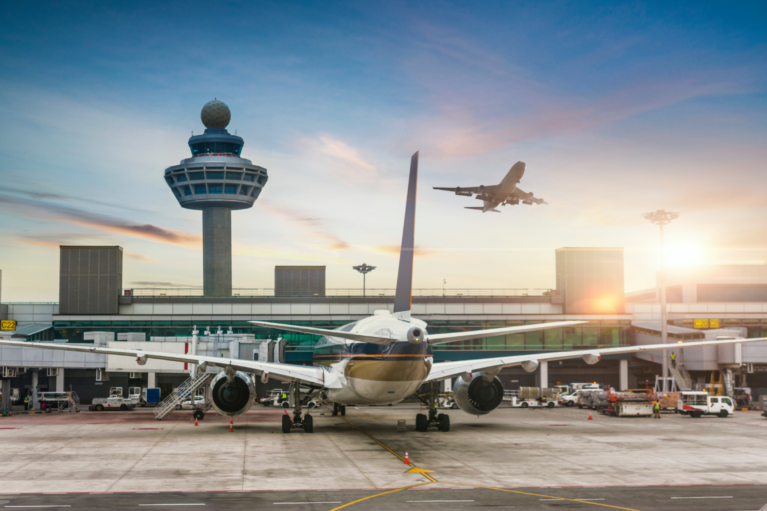If you think airports are chaotic on the surface, dig a little deeper, and you will be astonished by the sheer magnitude of what happens behind the scenes. Airports operate as intricate and well-oiled machines with many tiny cogs that work in tandem to ensure their smooth operation.
With every piece of technology running on electricity, a power failure here can have serious repercussions.
In this blog, we will look at the cascading effect of what power failures can do at an airport and why backup generators are vital to their operation.
The Inner Workings Of An Airport
Airports are complex transportation hubs that play a major role in contributing to the world’s economy. They directly support about 11.3 million jobs and about 18.1 million jobs indirectly via the aviation industry’s supply chain.
In 2023, airline passenger traffic is expected to generate $522 billion in revenue. These numbers give you a general idea about the size and scale of its operations.
That said, let’s look at the inner workings of an airport to understand them better.
The Physical Layout And The Facilities
Airports are vast and have designated areas to ensure a smooth flow of passengers. You have the:
Runways and taxiways that allow planes to take off, land, and taxi to the terminals. All of which are carefully coordinated.
You have the apron, a dedicated section where aircraft are parked, fueled, loaded, and unloaded. And finally, you have the main terminal comprised of everything from passenger check-ins to restaurants and retail outlets.
Operations
This is the part of the process which every passenger is familiar with. You check in, receive a boarding pass, complete the security check, and then move on to the departure area.
If you are traveling abroad, you go through immigration. All of which are heavily reliant on technology.
Ground Operations
Ground Operations are what goes on behind the scenes. Loading or unloading the airplanes and moving the luggage to the respective baggage claim areas.
Refueling, maintaining once, and cleaning of aircraft, and so on. With the sheer volumes of passengers and flights that go through an airport, these, too, are carefully coordinated thanks to sophisticated technology.
Air Traffic Control
The ATC’s primary task is the coordination and the safety of all incoming and outgoing aircraft in the airport.
They use a combination of radio, radar, and other complex tech to monitor every airplane near the airport and manage their movements.
What Would Happen In The Event Of A Power Failure?
While total blackouts in airports are rare, they do happen in the event of a total power failure. The answer is simple – the airport’s functions come to a grinding halt.
All flights about to take off are grounded, and all incoming flights are diverted to the nearest airports.
If we get into details if we look at the impact of the power loss on each area of operation of the airport, it would be something as follows:
Inside the airport terminal, passengers are stranded as all operations come to a standstill. To add to the voes of the passengers, the air-conditioning would no longer function.
The ATC would have no way to coordinate and manage operations without the ability to communicate with the ground crews and the aircraft.
It must be pointed out that the above scenario is based on the assumption that the emergency power backup systems have run out of juice themselves. That said, power outages do happen.
One of the busiest airports in the world, Los Angeles International Airport (LAX), was affected by a power failure in some areas of the airport.
On the 18th of Feb, 2023, Terminal 1 of New York’s John F. Kennedy International Airport faced a partial blackout due to a small electrical fire, leading to some flights being diverted to other airports or canceled.
Why Are Backup Generators Essential?
Power Failures at airports can cause chaos. Not only can it have serious consequences in terms of passenger convenience, safety, and security, but delays and cancellations also lead to a significant loss in revenue.
While all of an airport’s vital systems have backup power, these backups cannot sustain their operations for an extended period. All of the airport’s critical infrastructure is power-hungry and requires massive quantities of power to operate. That is where backup generators come into their own.
Backup generators can kick in in a matter of seconds to avoid any disruptions to airport operations.
Depending on the size of the airport and its power needs, multiple backup generators would be required to work in tandem to keep all systems up and running.
Which One Is Better For Airports: Backup Generators Or UPS Systems?
Traditional UPS systems use batteries or capacitors to store electricity and provide power backup in the case of an outage. While they can take over the power needs of an airport’s critical systems in milliseconds, they have limitations.
They are expensive and will require a significant investment to provide extended power backup for something as large as an airport. They are also limited when it comes to the loads they can handle.
Backup generators, however, can support large power loads and sustain them for a larger period, which can be days, weeks, or even months. They, too, require regular maintenance, but commercial generators are built tough and, when maintained well, can do their work without any issues for years.
That said, massive generators, depending on the make and model, need a few seconds to power up, which can lead to a momentary loss of power if they are the only backup power source.
The ideal solution is to use a combination of both to ensure zero power loss to critical systems in case of a grid failure. These systems are already in place in airports.
Learn more: 5 used generators for industrial data centers.
Summing It Up
In conclusion, airport power failures can have a cascading effect on all aspects of airport operations. This can lead to chaos, inconvenience, safety hazards, and financial losses.
Backup generators are essential to ensure that critical airport systems continue to operate in the event of a power outage. The ideal solution is combining backup generators and UPS systems to provide uninterrupted power to all critical systems.
Common Questions about Power Failures at Airport
1.What are the critical systems that need power back in an airport?
The ATC, Lighting, Security, Communications, and HVAC are critical systems that need a power backup at an airport.
2.Why are backup generators essential for an airport?
Backup generators are essential as they can provide large amounts of electricity that support the massive power demands of an airport for extended periods.
3.Are backup generators better than UPS systems for airports?
Backup generators and UPS systems each have their advantages and limitations. It’s best to use a combination of the two to overcome the limitations of each.
4.How often do backup generators need to be maintained?
The maintenance schedule of a generator depends on its type and the manufacturer’s recommendations. It also varies depending on how often and for how long the generator is used.
5.What factors need to be considered when choosing a backup generator for an airport?
The size of the airport and its power demands are the primary factors determining the size or the number of backup generators required for airports. The easy availability of fuel (Diesel or Natural Gas) should be considered when deciding what type of generator to go for.








